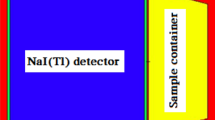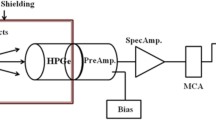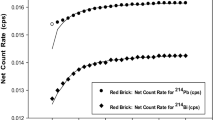Abstract
Lead attenuation characteristic curves are often consulted in premises radiation shielding assessments employing the non-destructive testing (NDT) method. This study developed lead attenuation characteristics mathematical models for the radionuclide Co-57. These models take into account the statistical variation of the attenuation characteristics. The results are a set of equations that a NDT assessor can use to predict the range of transmission factors for the NDT measurement or, using the inverse functions, to gauge the lead equivalence (with the associated uncertainty) of a radiation barrier. This study showed that the combined effect of types of statistical variations can form an uncertainty region on the transmission characteristics such that the relative uncertainty decreases for values of lead mass per unit area up to approximately 20kg/m2 and 15 kg/m2 for the Ludlum 18 and Ludlum 2241–2 survey meters respectively but thereafter increases.
Similar content being viewed by others
References
Kelly, John P. and Trout, E. Dale,Broad-Beam Attenuation in Lead for X Rays from 50 to 300kVp, Radiology, 104:171–175, July 1972.
Dixon, R. L. and Simpkin, D. J.,Primary Shielding Barriers for Diagnostic X-ray Facilities: A New Model, Health Physics, 74, 181–189, 1998
Simpkin, D. J. and Dixon, R. L.,Secondary Shielding Barriers for Diagnostic X-ray Facilities: Scatter and Leakage Revisited, Health Physics, 74, 350–365, 1998.
Radiation Shielding for Diagnostic X-rays, Ed. D. G. Sutton and J. R. Williams, The British Institute of Radiology, 2000.
Structural Shielding Design for Medical X-Ray Imaging Facilities, NCRP Report 147, National Council on Radiation Protection and Measurements, 2005.
Simpkin, Douglas J.,Transmission Data for Shielding Diagnostic X-Ray Facilities, Health Physics, 68(5), 704–9, 1995.
Schick, D. K., Casey, R. N., Sim, L. H. and Siddle, K. J.,Corrosion of lead shielding in a radiology department, Australasian Radiology, 43(1), 47–51, 1999.
Westall, D. J. and Rubendra, R.,Inspection of Radiation Shielding Installed at Diagnostic Radiology Facilities. Australasian Physical & Engineering Sciences in Medicine. 11(4), 147–9, 1998.
Westall, D. J.,Development of a System for Checking Radiation Shielding Installed at Diagnostic X-ray Facilities, Radiation Protection in Australia, 5, 131–133, 1987.
Knoll, G. F.,Radiation Detection and Measurement, 3rd Ed., John Wiley and Sons, p. 70 and 73, 2000.
Ludlum Model 18 Analyzer — Serial No. 95384 and Succeeding Serial Numbers, Ludlum Measurements, Inc., June 1992.
Ludlum Model 2241–2 Survey Meter — Serial No. 237627 and Succeeding Serial Numbers, Ludlum Measurements, Inc., July 2007.
Kreyszig, E.,Advanced Engineering Mathematics, 8th Ed., John Wiley and Sons, p. 1116, 1999.
Wilton Pereira da Silva and Cleide Pereira da SilvaLabFit V.1.0.0.1, www.labfit.net.
Author information
Authors and Affiliations
Corresponding author
Rights and permissions
About this article
Cite this article
Lee, K.L., Schick, D. Lead attenuation characteristics models. Australas. Phys. Eng. Sci. Med. 32, 212–219 (2009). https://doi.org/10.1007/BF03179241
Received:
Accepted:
Issue Date:
DOI: https://doi.org/10.1007/BF03179241




